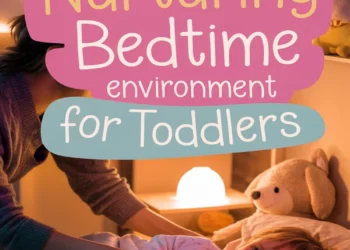Co-sleeping can foster closeness with your baby, but safety is key. Use a firm mattress, keep the sleep area free from soft bedding, and always place your child on their back to sleep. Ascertain there’s enough space for everyone and monitor the room temperature. Be cautious if you’ve consumed alcohol or drugs. By following these practices, you can enjoy the benefits of co-sleeping while minimizing risks. Discover additional tips and insights on creating a secure sleep environment.
Understanding Co-Sleeping: Benefits and Risks
When considering co-sleeping, it’s important to weigh both the benefits and risks for your family. Co-sleeping can foster a strong emotional bond between you and your child, providing comfort and security. Many parents appreciate the convenience it offers during nighttime feedings, making it easier to soothe a restless baby. However, it’s crucial to recognize the potential risks involved, such as suffocation, overheating, and disrupting your child’s sleep independence. Awareness of these factors is significant in making an informed choice. Assess your family’s dynamics and parenting style to determine if co-sleeping aligns with your goals. By understanding the benefits and risks, you can create a loving environment that supports your child’s development while ensuring everyone’s safety and well-being.
Recommended Items
Discover our top picks for safe and comfortable co-sleeping—perfect for nurturing your family bond!
Establishing Safe Sleep Guidelines
Creating a safe sleeping environment is crucial for families who choose co-sleeping. First, make certain that your mattress is firm and free from any soft bedding, pillows, or toys that could pose a suffocation risk. Always place your baby on their back to sleep, as this noticeably reduces the risk of Sudden Infant Death Syndrome (SIDS). Ascertain there’s enough space for everyone, ideally alongside an adult who can maintain proper positioning. Monitor the room temperature to avoid overheating, and dress your baby in light sleep clothing instead of heavy blankets. Finally, avoid co-sleeping if you’ve consumed alcohol, drugs, or are extremely fatigued, as this may compromise your ability to respond to your child’s needs effectively.
Choosing the Right Sleep Surface
Choosing the right sleep surface is vital to guarantee both your baby’s safety and your peace of mind. Ideally, opt for a firm and flat mattress that meets safety standards. Avoid soft surfaces like sofas or armchairs, as these increase the risk of suffocation. If you’re co-sleeping in a bed, make sure that your mattress is free of gaps or heavy blankets that could pose a hazard. Consider using a co-sleeper attachment that securely connects to your bed, providing a designated space for your baby while maintaining closeness. Always prioritize a well-fitting fitted sheet, avoiding pillows, toys, or loose bedding around your baby. By carefully selecting a sleep surface, you’re taking important steps to create a safe and comforting sleeping environment for your little one.
Creating a Safe Co-Sleeping Environment
Ensuring your baby’s safety while co-sleeping requires careful attention to your environment. Start by choosing a firm, flat surface free of soft bedding, pillows, and heavy blankets that could inadvertently cover your baby. Position your baby on their back, away from the edge of the bed. Avoid co-sleeping with older children or pets, as they may unintentionally disturb your baby’s sleep. Additionally, keep the room at a comfortable temperature to prevent overheating. Consider using a co-sleeper or a sidecar crib for an added layer of safety. Always remain mindful of your own sleep position, ensuring you don’t roll over on your baby. Taking these simple steps can help create a secure co-sleeping environment for both you and your baby.
Monitoring Your Baby’s Sleep Patterns
While co-sleeping can foster a strong bond between you and your baby, keeping an eye on their sleep patterns is essential for their well-being. Pay attention to how often your baby stirs, wakes up, or changes positions throughout the night. These cues can indicate their comfort level, feeding needs, or sleep quality. It’s beneficial to keep a sleep journal, noting the times and duration of your baby’s sleep, which can help you identify any patterns or irregularities over time. This information can also be valuable when discussing your baby’s sleep habits with a pediatrician. Understanding your baby’s sleep cycles can help you respond appropriately to their needs, fostering a reassuring environment conducive to safe co-sleeping.
Action Steps for Safe CoSleeping
Best Positions for Co-Sleeping
Understanding your baby’s sleep patterns can markedly enhance how you approach their sleeping arrangements. When co-sleeping, consider positioning your baby on their back, which is the safest option to reduce the risk of sleep-related incidents. You might also find it effective to place your baby in a side-car arrangement, where a crib or bassinet is adjacent to your bed, allowing easy access while maintaining safety. Another helpful position is the “Cuddle Curl,” where you gently cradle your baby in the crook of your arm, guaranteeing they’re secured. Always keep pillows, blankets, and other bedding away from your baby to reduce hazards. Regularly assess your positioning to guarantee both your comfort and your baby’s safety throughout the night.
Using Co-Sleeping Aids and Accessories
Co-sleeping aids and accessories can greatly enhance your family’s sleep experience, creating a safer and more comfortable environment for both you and your baby. Using a co-sleeper or sidecar crib can provide a secure space for your little one while keeping them close. These products often feature breathable materials and firm surfaces, minimizing safety risks. Additionally, consider investing in a baby monitor for extra peace of mind; this tool allows you to hear or see your baby without disturbing their sleep. Soft, breathable bedding can also make your shared space cozy while maintaining safety standards. Always check for safety certifications to guarantee the products you choose meet the highest standards, helping you feel confident and secure during your co-sleeping journey.
Co-Sleeping With Multiple Children
As you explore co-sleeping aids and accessories to enhance your family’s sleep environment, you might be considering how to navigate co-sleeping with multiple children. Juggling bed space can be tricky, but with some planning, it can be a rewarding experience for everyone.
- Use a larger bed or mattress to accommodate everyone comfortably.
- Designate specific spots for each child to help avoid fights.
- Invest in bed rails for safety and security.
- Make a consistent bedtime routine to ease the change.
- Encourage individual sleep items, like blankets or stuffed animals, to provide comfort.
Transitioning From Co-Sleeping to Independent Sleep
While moving to independent sleep may feel challenging, it’s an important step in fostering your child’s autonomy and self-soothing skills. Begin by creating a comforting bedtime routine to help ease the change. Gradually introduce a separate sleeping space, ensuring it’s inviting and safe.
| Emotion | Your Child’s Needs | Your Parenting Goals |
|---|---|---|
| Anxiety | Consistency and Reassurance | Encourage independence |
| Sadness | Emotional Support | Build self-soothing |
| Excitement | Empowerment | Celebrate milestones |
Monitoring your child’s feelings throughout the process is crucial. Be patient and supportive; it’s normal for both of you to feel a mix of emotions as you initiate this important journey towards independent sleep.
Discussing Co-Sleeping With Your Partner
Shifting your child to independent sleep presents an opportunity to open a dialogue with your partner about co-sleeping practices. It is crucial to approach this conversation with empathy and understanding, acknowledging both of your feelings and experiences. Consider the following points to guide your discussion:
- Share your thoughts on co-sleeping benefits and concerns.
- Discuss personal comfort levels regarding this sleeping arrangement.
- Explore how co-sleeping affects your relationship and intimacy.
- Address any cultural or family influences affecting your perspectives.
- Set boundaries for sleep arrangements, ensuring both partners feel heard.
Cultural Perspectives on Co-Sleeping
Cultural perspectives on co-sleeping vary widely around the world, reflecting deep-rooted traditions and values. In many cultures, sharing a sleeping space promotes bonding and security for both parents and children. For example, in numerous Asian and African societies, co-sleeping is commonplace, seen as an essential part of early childhood development. Conversely, in Western cultures, it’s often met with skepticism, associated with safety concerns. Understanding these cultural nuances can help you navigate your own co-sleeping decisions more thoughtfully. You may find that weighing your personal beliefs against these cultural perspectives fosters a balanced approach, allowing you to prioritize your family’s needs while being respectful of traditional practices. Ultimately, it’s about creating a nurturing environment that feels right for you and your child.
Managing Sleep Disruptions: Tips for Parents
Managing sleep disruptions can feel overwhelming, especially when you’re trying to navigate the delicate balance between parental duties and the need for rest. To help ease these challenges, consider the following strategies:
- Create a calming bedtime routine for both you and your child.
- Keep the sleep environment comfortable, dark, and quiet.
- Gradually introduce your child to independent sleep away from co-sleeping.
- Share nighttime responsibilities with your partner, if possible.
- Be patient and adjust your expectations during sleep shifts.
Implementing these tips can lead to a more restful night for everyone involved, making co-sleeping a positive experience. Remember, it’s normal for sleep patterns to fluctuate as your child grows, so be kind to yourself during this process.
Addressing Common Misconceptions About Co-Sleeping
Many parents have heard various misconceptions about co-sleeping that can lead to unnecessary worry and confusion. One common myth is that co-sleeping always increases the risk of suffocation, but when done safely, risks can be minimized. Contrary to belief, co-sleeping doesn’t hinder a child’s independence; many co-sleeping families report children eventually adapting to their own beds quite naturally. Another misconception suggests that co-sleeping leads to poor sleep habits, yet many parents find that sharing sleep promotes better rest for everyone. It’s essential to recognize that every family’s situation is unique. By staying informed and creating a safe sleep environment, you can confidently enjoy the benefits of co-sleeping without fear or doubt.
When Not to Co-Sleep
While co-sleeping offers benefits for some families, it’s important to recognize scenarios when it may not be the best choice. Your child’s safety and well-being should always come first. Here are some situations where you might want to reconsider:
- If you or your partner smoke
- When you’re excessively tired or under the influence of drugs
- If your baby was born prematurely or has low birth weight
- When sharing a bed with older children or pets
- If you have a waterbed, sofa, or soft bedding
In these cases, opting for a separate sleep space can guarantee your child stays safe while still fostering closeness in other ways. Always prioritize a sleep environment that supports everyone’s safety and comfort.
Resources for Further Reading on Safe Co-Sleeping
Finding reliable resources for safe co-sleeping can greatly enhance your understanding and implementation of best practices. Books like “The No-Cry Sleep Solution” by Elizabeth Pantley offer valuable insights, while organizations such as the American Academy of Pediatrics provide guidelines you can trust. Websites like La Leche League and the National Sleep Foundation also feature articles addressing co-sleeping safety. Additionally, parenting forums and support groups can connect you with experiences and advice from other parents traversing this journey. Don’t hesitate to consult your pediatrician for personalized guidance tailored to your specific situation. Understanding various perspectives and expert recommendations will empower you to make informed decisions that prioritize your family’s well-being and foster a nurturing sleeping environment.













